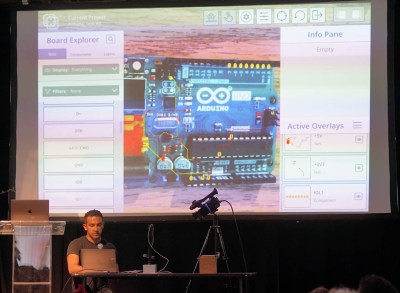Mihir Shah has designed many a PCB in his time. However, when working through the development process, he grew tired of the messy, antiquated methods of communicating design data with his team. Annotating photos is slow and cumbersome, while sending board design files requires everyone to use the same software and be up to speed. Mihir thinks he has a much better solution by the name of InspectAR, it’s an augmented reality platform that lets you see inside the circuit board and beyond which he demoed during the 2019 Hackaday Superconference.

The idea of InspectAR is to use augmented reality to help work with and debug electronics. It’s a powerful suite of tools that enable the live overlay of graphics on a video feed of a circuit board, enabling the user to quickly and effectively trace signals, identify components, and get an idea of what’s what. Usable with a smartphone or a webcam, the aim is to improve collaboration and communication between engineers by giving everyone a tool that can easily show them what’s going on, without requiring everyone involved to run a fully-fledged and expensive electronics design package.
The Supercon talk served to demonstrate some of the capabilities of InspectAR with an Arduino Uno. With a few clicks, different pins and signals can be highlighted on the board as Mihir twirls it between his fingers. Using ground as an example, Mihir first highlights the entire signal. This looks a little messy, with the large ground plane making it difficult to see exactly what’s going on. Using an example of needing a point to attach to for an oscilloscope probe, [Mihir] instead switches to pad-only mode, clearly revealing places where the user can find the signal on bare pads on the PCB. This kind of attention to detail shows the strong usability ethos behind the development of InspectAR, and we can already imagine finding it invaluable when working with unfamiliar boards. There’s also the possibility to highlight different components and display metadata — which should make finding assembly errors a cinch. It could also be useful for quickly bringing up datasheets on relevant chips where necessary.
Obviously, the electronic design space is a fragmented one, with plenty of competing software in the market. Whether you’re an Eagle diehard, Altium fanatic, or a KiCad fan, it’s possible to get things working with InspectAR. Mihir and the team are currently operating out of office space courtesy of Autodesk, who saw the value in the project and have supported its early steps. The software is available free for users to try, with several popular boards available to test. As a party piece for Supercon, our very own Hackaday badge is available if you’d like to give it a spin, along with several Arduino boards, too. We can’t wait to see what comes next, and fully expect to end up using InspectAR ourselves when hacking away at a fresh run of boards!
















Boeing has been using augmented reality displays for decades to troubleshoot wiring harnesses, they made a prototype in the 1990s using the Private Eye heads-up display. Debugging an Arduino is simple and straightforward compared to tracing out the wires inside an airplane wing. Boeing is totally paranoid about this stuff after they lost a plane due to crossed wires.
You’re totally right! This is Mihir from inspectAR, here. The arduino is a really simple example used here to just get the idea across. You can use inspectAR on far more complicated, HDI-type boards to really help understand what’s going on for any rework, hand-assembly, and debugging purposes. It becomes especially useful when screensharing and bringing other engineers into your lab environment without having them physically there — makes support and collaboration that much more effective. Same goes for assigning tasks like tests and rework instructions… much easier to explain by highlighting interactive pads, than spending time in Paint or Powerpoint to draw out instructions. Check out the free version at inspectar.com/sign-up-free. If you have any other questions or comments, please send them directly to me at mihir@inspectar.com!
A bit more details? Sounds fascinating!
Thanks! Check out the free version at inspectar.com/sign-up-free, and watch our tutorial and demo videos on our youtube page: https://www.youtube.com/watch?v=YUVcjhGFMMA
Boeing has more serious problems that that. Like incorrectly designing a system to take over the control of an airplane with only one easily damaged sensor as input.
Will that feature come to Fritzing now that development has resumed?
Neat. I assume it will calibrate and work under a microscope camera, with changing zooms?
I think this is amazing!
Thank you! Please try out the free version at inspectar.com/sign-up-free and send us any feedback!